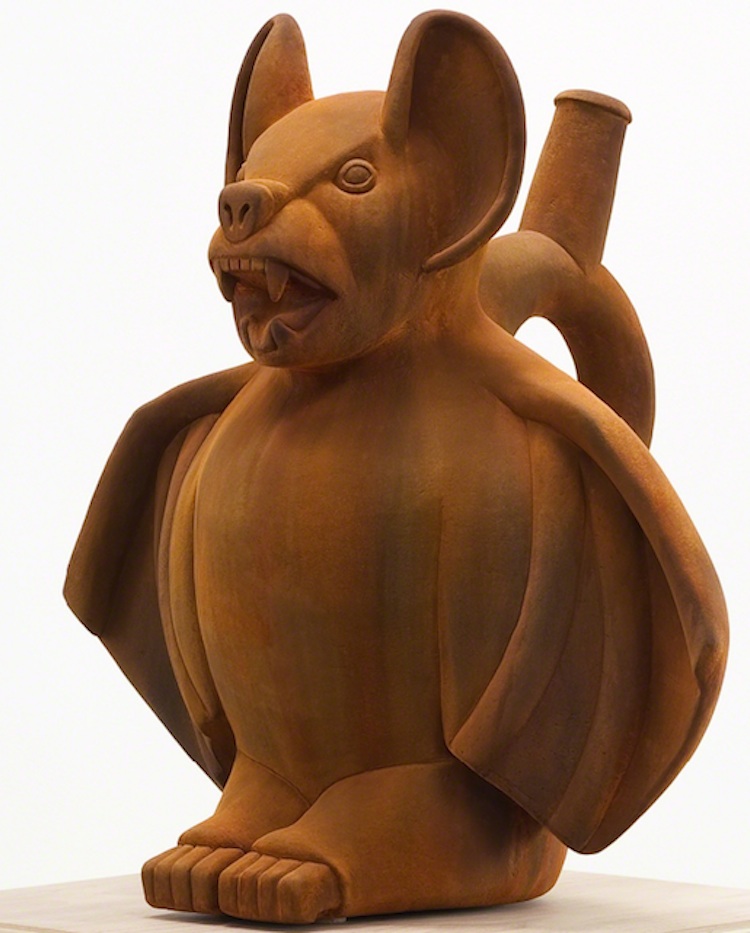LOS ANGELES — The Saatchi Gallery compares Nathan Mabry to an electronic musician who samples from other songs in order to define his or her own sound. In Mabry’s work classics of Western sculpture and ethnographic art sometimes find themselves juxtaposed with signifiers from contemporary culture, or items as bizarre as clown noses or Halloween masks.
This is sometimes used for humor, but — as is the case with musical sampling— these quotes from other sources (fertility gods, Rodin, Halloween, the devil horns hand sign) put the work in context and give you a way to read it. The message is in comparing and contrasting the different signs. Though I suppose someone could (or has) accused the artist of cultural appropriation, the artist terms it “anonymous iconography,” which I suppose means using the visual language of such things without zeroing in on any culture in particular.

Nathan Mabry, T/O/T/E/M/ (…blind as a…), 2013, terracotta, walnut plywood, plexiglass. Courtesy of Cherry and Martin, Los Angeles.
Fertility idols are easy to read visually, communicating their purpose and worldview with a simple image. In A Very Touching Moment (Pitching a Tent) Mabry shows us two such idols making out, one of them is erect. The combination of the figures with juvenile humor allows us to hold two conflicting ideas in our head at the same time. Sex is both holy and profane; fertility propagates the world and yet its methods are full of spit and mucous and sinew and spongy tissue filling with blood. It can be spiritual, but it’s more often crassly biological. The skull faces can’t be ignored either; so much of humanity exists because people were trying to secure immortality through their offspring. Procreating is like a race against your own demise, which makes it seem desperate rather than holy.

Nathan Mabry, T/O/T/E/M (…sly like a…), 2013, terracotta, walnut plywood and plexiglass, 63 x 18 x 18 inches
The sculptor described his “mash ups” to Paul Laster of Bomb Magazine:
Paul Laster: Do you remember the moment that you first hit upon the idea of creating cultural mash-ups between ethnographic art and Minimalist sculpture?
Nathan Mabry: There wasn’t really a pure defining moment. Basically, I have always been interested in dualities, dichotomies, and juxtapositions. This had led me to explore aesthetic combinations of visual tropes, sociological values, and diverse cultural material.
I first investigated the “authorized” Minimal object in conversation with the “anonymous” ethnographic iconography a few years ago. These objects in unison exemplify the perfect debate involving aesthetics, philosophy, and psychology.

Nathan Mabry, T/O/T/E/M (…in a row…), 2014, ceramic, ash plywood, plexiglass, patina, 62 x 22 x 18 inches

Nathan Mabry, T/O/T/E/M (…would have bit you…), 2014; ceramic, red oak plywood, plexilass, patina, 66 x 18 x 18 inches
Jori Finkel, writing for Blouinartinfo wrote about Mabry’s fondness for EBay, listing everything in the studio from recreations of Rodin and Michelangelo sculptures to latex masks and West African drums. That, coupled with George Melrod’s article for Visual Art Source, reveals something interesting about Mabry’s practice.
Mabry’s own studio, on the southern edge of Culver City, contains an equally diverse hodgepodge of artworks and materials (not surprising, for someone who studied with Paul McCarthy and Adrian Saxe at UCLA). Near the door are a pair of African statues–Senufo Rhythm Pounders from the Ivory Coast (or knockoffs), the same sort of statues he thinks Lipchitz may have been looking at when he created Figure. “A lot of people don’t know how Henry Moore was inspired by pre-Columbian,” he notes, as we shift to pre-Columbian. There’s also a maquette of another Tony Smith-type piece; a cast model of Rodin’s 1889 Burghers of Calais; some masks of team mascots (a bull, a cat, a pirate); a large-size B&W folio of Picasso’s works, barely bound together. Thumbing through it, we find a page on Picasso’s sculpted Tete d’Marie Therese : its eyes and nose bulging. “They look like Muppets, so goofy…” he observes, admiringly.
Fine art isn’t hermetically sealed, according to Mabry. It’s a facet of culture that is in dialogue with all other pieces of culture, and different cultures as well. It sounds trite to point that out, to say that art can’t occur in a vacuum, but our own behavior surrounding art reveals that we don’t really believe that. If we did, Melrod wouldn’t have to add “admiringly” to the end of the sentence. He wrote it because otherwise it sounds like Mabry is trying to drag down Picasso. Instead, Mabry is using his poetic imagination to find connections between ideas that seem to oppose each other.
For this post we’re using pictures from Mabry’s T/O/T/E/M series. The sculptor took English idioms about animals and turned them idols. By casting them in this way he shows us the magical reasoning hiding in our own language.
Do you love or loeathe these works of contemporary ceramic art? Let us know in the comments.



Add your valued opinion to this post.